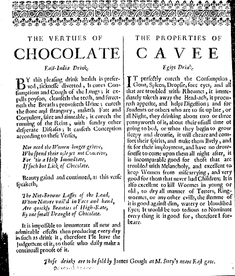 Anon. 1660 Wing / 1961:07 Anon. 1660 Wing / 1961:07 As I'm finishing up my third historical mystery--The Masque of a Murderer--I found that I still had a few more things to research. In particular, what would commoners living in 17th-century London have known of chocolate, and how might they have experienced it for the first time? References to "chocolate" in England can first be found in the 1640s. Of course, "chocolate" as a substance had been around for several thousand years as Smithonian.com explains, originating in Mesoamerica. However, it did not find its way to Europe until the early seventeenth century, as one of the strange products imported from the New World. The word "chocolate" comes from the Aztec word "xocoatl," (or is it the Nahuatl word chocolatl?) referring to a bitter drink derived from cacao beans, with medical and health properties (for more about the etymology of the word, check out Oxford Dictionaries blog for ten facts concerning the word Chocolate... ). By the 1650s, several discourses on the "physicks" and health properties of chocolate were in circulation in London. In 1640, "A Curious Treatise of the nature and quality of Chocolate" by Antonio Colmenero, a Spanish"Doctor in Physicke and Chirurgery, was translated into English. More significantly, Henry Stubb published the far more substantial treatise on "The Indian Nectar" in 1662. We know too, from a collection of 1667 statutes from King Charles II that there were restrictions on who could sell chocolate: "And be it further Enacted by Authority aforesaid, That from and after the said first day of September, no person or persons shall be permitted to sell or retail any Coffée, Chocolate, Sherbet or Tea, without License first obtained and had by Order of the General Sessions of the Peace in the several and respective Counties,etc etc." This makes me reasonably certain that chocolate would have been sold at coffee houses, for those would have been the establishments likely to acquire such a license. It is unlikely that chocolate would have been sold at taverns or alehouses, at least in early Restoration England, due to the great dispute between those who sold wine and beer, and those who sold coffee. Chocolate might have been procured for medicinal purposes as well, although it is unclear to me--at least at this preliminary stage--whether it would have been actively prescribed by a physician. However, if the "Virtues" are to be believed (of course, that's if they are to believed), chocolate cures infertility, "ill complexion," digestive illnesses, consumption and "coughs to the lungs," "sweetens the breath," "cleaneth the teeth," "provoketh urine" and "cureth the stone." Apparently, this miracle drug also cures "the running of the reins," (the last a euphemistic biblical reference to venereal disease). Who knew? I have to surmise a bit here, on how popular chocolate truly was in Restoration London. But I think it's reasonable to assume, especially once sugar became a more common household good, that it would have been become popular fairly quickly. (Although it's also likely that it remained in the realm of the elite and wealthy, for quite some time.) But what do you think? England and Wales. A collection of the statutes made in the reigns of King Charles the I. and King Charles the II. with the abridgment of such as stand repealed or expired. Continued after the method of Mr. Pulton. With notes of references, one to the other, as they now stand altered, enlarged or explained. To which also are added, the titles of all the statutes and private acts of Parliament passed by their said Majesties, untill this present year, MDCLXVII. With a table directing to the principal matters of the said statutes. By Tho: Manby of Lincolns-Inn, Esq. 1667 Wing (CD-ROM, 1996) / E898
Wing / 2532:08
2 Comments
Murder, Mayhem and a Midwife...An interview with historian Sam Thomas, author of The Midwife's Tale1/8/2013 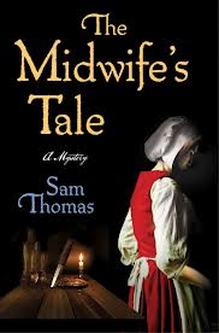 I'm excited to have historian Sam Thomas join me today to discuss his first novel, The Midwife's Tale, a historical mystery set in mid-seventeenth century York. Sam and I connected about a year ago, when we realized that (1) we're both trained as early modern English historians; (2) we both have debut novels coming out with Minotaur Books this year; and (3) both our mysteries are set in nearly the same time period. (I'm encouraging Sam to think about doing a cross-over piece, so that his midwife can bring my Lucy Campion into the world. But I digress.) -------------------------------------------------------------------------------------------------------- The Official Description: It is 1644, and Parliament’s armies have risen against the King and laid siege to the city of York. Even as the city suffers at the rebels’ hands, midwife Bridget Hodgson becomes embroiled in a different sort of rebellion. One of Bridget’s friends, Esther Cooper, has been convicted of murdering her husband and sentenced to be burnt alive. Convinced that her friend is innocent, Bridget sets out to find the real killer. Bridget joins forces with Martha Hawkins, a servant who’s far more skilled with a knife than any respectable woman ought to be. To save Esther from the stake, they must dodge rebel artillery, confront a murderous figure from Martha’s past, and capture a brutal killer who will stop at nothing to cover his tracks. The investigation takes Bridget and Martha from the homes of the city’s most powerful families to the alleyways of its poorest neighborhoods. As they delve into the life of Esther’s murdered husband, they discover that his ostentatious Puritanism hid a deeply sinister secret life, and that far too often tyranny and treason go hand in hand. -------------------------------------------------------------------------------------------------------- 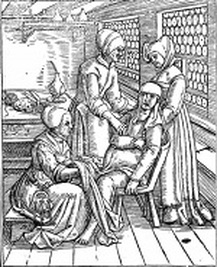 A midwife at work The Midwife's Tale is told through the first person perspective of Lady Bridget Hodgson, a 30-year old twice-widowed midwife and real historical figure. How much is known of the true Bridget, and how much of her personality/character did you invent? Did you ever feel constrained writing a fictionalized account of a real person? That’s a great question! We know a fair bit about Bridget, and I include some of it here. A lot of the basics are true: She was twice widowed, first to a man named Luke Thurgood, then to Phineas Hodgson, who was the son of the Lord Mayor of the York. (And yes, Phineas seems to have been every bit the loser I portray him as.) Bridget also had a deputy named Martha, though I had to invent much more of her background. It is also pretty clear that she was a very strong woman. She came from an ancient family and wanted people to know it. She also named all of her goddaughters (as well as her own daughter) ‘Bridget’, presumably after herself. Who does that? I did, however, make some cuts. For my first book I had a heck of a time writing her home life, so I made her childless, though the historical Bridget was survived by two daughters. There are also rumors that she had two sons, both of whom were hanged as highwaymen, which is amazing, but I’m not sure I believe it. 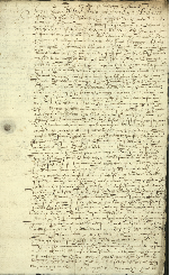 Bridget's Will Similarly, is the case at the heart of The Midwife's Tale based on a true case from the archives? How did you go about doing your research? The case itself is entirely fictional, though a lot of the supporting characters are real. As for the research it was a lot of digging. I stumbled across Bridget’s will when I was working on another project, and it provided dozens of names for me to chase down: friends, family, and best of all, godchildren, which allowed me to identify a handful of clients. Once you have names, you can then dig into baptismal registers, tax records, probate documents, legal records, histories of York…it’s endless, really. I also got very lucky that Bridget was once sued for defamation, which allowed me do dig even further into her social life and the history of her practice. Besides being a compelling read, your story gets at some of the larger historical themes around gender, politics and religion that shaped this time period. In what ways did you consciously try to illuminate these larger trends? How did you balance the need for historical accuracy with creative license? I consciously wanted to connect ‘big’ and ‘little’ history. The novel takes place in the midst of a rebellion against the king, so I made the crime at its heart a domestic rebellion in which a wife is accused of murdering her husband. This was a time when people were intensely concerned about maintaining order at the national and domestic levels, and I wanted to see how they would react when that order was challenged. (Oddly – or not – I do much the same thing in my historical work, favoring microhisotry, in which big stories are told through the lives of average individuals.) In doing your research, what was one of the most interesting things you learned? I think it was how complicated life as a midwife could be. Not only did they deliver children, they were part of the legal system, investigating crimes ranging from infanticide, to rape, to witchcraft. It really makes midwives the perfect sleuths! 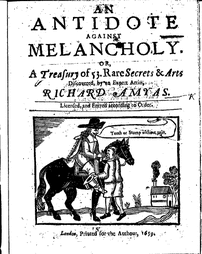 Rare hosting tips! (Wing A3032A ) Hosting a dinner party? Why not try these fun seventeenth-century tips... Richard Amyas has 53 in his treasury, I'll give you ten.. First, you'll want to make your house ready for your guests: 1. Make Rats forsake a House: Burn Assafettida in the Roof of the House often, and the Rats will forsake and fly from the House in a short time. (Assafettida, also known as "devil's dung, tastes like leeks. Apparently. Someone can let me know). 2. Make a Light that will continue always: Take the Liquor of Glow-worms, mix it with a quarter of the quantity of quick|silver, and put it into a Vi[...]l, hang it up in the Room, and you may see all night long by the light. (Nifty, if you've got lots of glow-worms on hand!) 3. Catch Fleas in a trap: Take a piece of Tin made like a dripping-pan, the length and bigness of a small trencher, then put over it 5 or 6 small wires made fast to the Tin, bowed like the hoops over a waggon, then fill the Tin with Venice Turpentine mixt with a little honey, then put this Trap in the Bed in the morning when you rise, between the sheets, and there you shall find the Fleas stick in the Turpentine, as thick as Wasps in a Honey-pot. (Alrightee then!) Why not try these parlour--ahem, withdrawing room--tricks? Wow and amaze your guests!!! 4. Write your name on a piece of Paper, and burn that piece of Paper & the same letters to appear on the back of your hand. (Got that?) To do this, first write the Name on a small piece of Paper; then privately write the same Letters on the back of your hand, with a Pen-ful of your own Urine, which none can perceive: then burn that Paper· and as it is almost burnt, clap it upon the back of your hand, and rub it, & there will strangely appear the same letters on the back of your hand, with admiration to the Beholders. (Ah, the secret hidden urine trick. Classic!) 5. Make Pease leap out of the pot as if they were mad. Put a Quill or two of Quick-Silver into the pot, and all the Pease shall leap out of the pot. (Well, now that just sounds fun!) (They're seem to be a number of related tricks like this: To make a blown Bladder dance and skip about the room; to make a penny-loaf tumble, and skip up and down on it self; to make a ring dance on a table of it self...Basically, just add quicksilver to anything, and the object will look mad!!! A handy substance, to be sure!) 6. Make an Apple to move on a Table of it self: A fine secret. (and guess what, no quick silver!) Cut an Apple in the midst, and in the one half make a round hole, putting therein a black Beetle, and so lay the half on the table, and it will move about the table. 7. Make a Chamber to appear full of Addors and Snakes. (Now THAT'S got to be a parlor trick you don't see every day!) Kill a dozen Adders and Snakes, and take the oyl of them, and mix it with wax, and make a Candle, light it in a Chamber where rushes are, and the rushes will appear to be Adders and Snakes about the Room. (Somehow I feel there's a corollary woodcut somewhere--how to trick your friends into being bitten by a poisonous snake by letting them think they are preparing a neat trick themselves...) And at the end of the night, if your guests aren't bidding timely farewells... 8. Fright the people of a house, and make them believe there are Spirits walking in a Room. To do this, take a black or gray Cat; then take 4. Walnut-shells, put Pitch in them, beat it, and put on every foot one; and tye a certain piece of rotten wood, which you shall find to shine in a dark night about the Cats Neck, and put her in a boarded Room, she will so trample about the Room, to the amazement of them that know not what you have done; and the moist piece of rotten wood (if they peep in at the key|hole, or chink of the door) it will seem to be like fire. And if the scare-the-bejezus-out-of-your-guests doesn't work... 9. Clear a Room of drunken or rude company. Take a Chafingdish of clear Charcoals, or live Wood-coals; throw Giney Pepper on it, and put it under the table, and they will both cough, sneez, fart, and spew, if they have drunk hard. (What can I say? What can I say?) And to make sure everyone thinks your party was a success (even if it wasn't)... 10. Make a Tell-tale or Gossip, to trump about: the house an hour or two shooting off the great Guns. Take the Liver of a Hare dryed in an Oven, and made into fine Powder; mix it with the Eggs of yellow Ants, or Pismires, put it into the Parties broth, or into Beer with Sugar and Nutmeg to discolour it: then an hour after employ the party to draw off a straight pair of Boots, or the like Exercise, and he'l make cracking off about bravely. (Okay, I have to admit, I'm not sure I understand this one. I think this mixture will make people think they've been to the coolest party ever...) And just think--Amyas had 43 more of these gems! Who wouldn't want to party 1659-style? 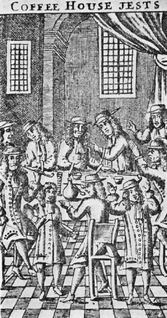 Given that over the last twenty years I’ve spent much of my free time writing in random coffee shops, I thought today I’d say something about The Vertue of the Coffee Drinke, as described by Anonymous in 1652. Coffee had just become popular in England--and its pretty clear why. To benefit fully from coffee, Anonymous tells us how much to drink ("half a pint"), when to drink it ("fasting an hour before, and not Eating an hour after"), and temperature ("to be taken as hot as possibly can be endured," but not so much as to "fetch the Skin off the Mouth, or raise any Blisters.") (I wish I'd learned this last when I first started drinking coffee; I'm fairly certain I don't have front taste buds anymore). Coffee, Anonymous assures us, is good for digestion (being "of great use to be taken about three or four of the Clock in the afternoon, as well as in the morning), will improve our sight ("being very good against sore eyes") and will give us a nice happy buzz ( it will "very much quicken the Spirits, and make the heart lightsome.") This last point might have something to do with how well coffee "suppresseth fumes exceedingly," but I could be wrong. And WAIT! There's more!!! Coffee will prevail against "the Headache," diminish the "deflusion of Rhemes," (whatever that is), and will even prevent consumption and the cough of the lungs. Coffee will prevent dropsy, gout, the scurvy, any running humors, "hypocondriak windes," and, if you were worried, yes, it will even rid you of the "king's evil." You can have your flu shots, your hospitals, your vitamins, and your vaccinations... But I'm sticking with Anonymous and my daily cup of coffee. I'm sure I'll be fine. What do you think? |
Susanna CalkinsHistorian. Mystery writer. Researcher. Teacher. Occasional blogger. Categories
All
Archives
May 2023
|
 RSS Feed
RSS Feed